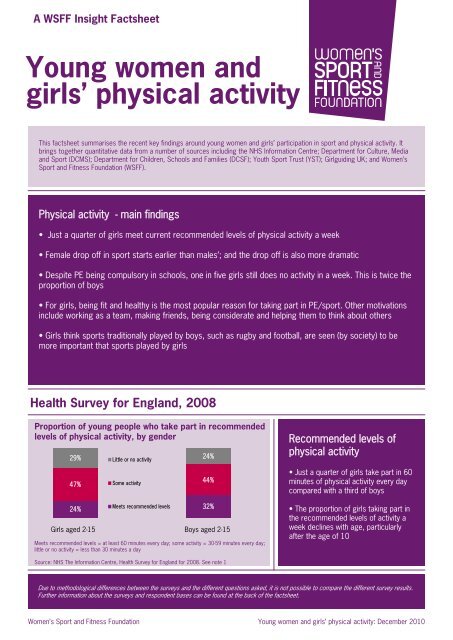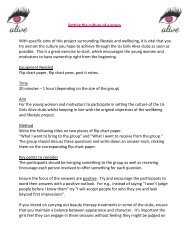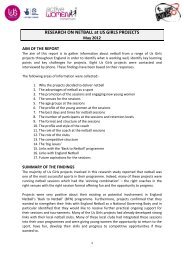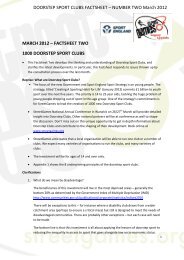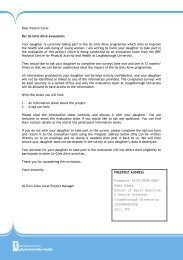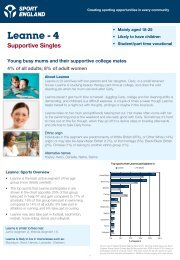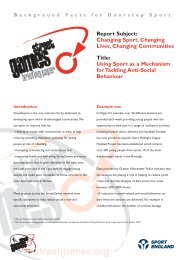factsheet - young women and girls physical activity - Women's Sport ...
factsheet - young women and girls physical activity - Women's Sport ...
factsheet - young women and girls physical activity - Women's Sport ...
You also want an ePaper? Increase the reach of your titles
YUMPU automatically turns print PDFs into web optimized ePapers that Google loves.
A WSFF Insight Factsheet<br />
Young <strong>women</strong> <strong>and</strong><br />
<strong>girls</strong>’ <strong>physical</strong> <strong>activity</strong><br />
This <strong>factsheet</strong> summarises the recent key findings around <strong>young</strong> <strong>women</strong> <strong>and</strong> <strong>girls</strong>’ participation in sport <strong>and</strong> <strong>physical</strong> <strong>activity</strong>. It<br />
brings together quantitative data from a number of sources including the NHS Information Centre; Department for Culture, Media<br />
<strong>and</strong> <strong>Sport</strong> (DCMS); Department for Children, Schools <strong>and</strong> Families (DCSF); Youth <strong>Sport</strong> Trust (YST); Girlguiding UK; <strong>and</strong> Women’s<br />
<strong>Sport</strong> <strong>and</strong> Fitness Foundation (WSFF).<br />
Physical <strong>activity</strong> - main findings<br />
• Just a quarter of <strong>girls</strong> meet current recommended levels of <strong>physical</strong> <strong>activity</strong> a week<br />
• Female drop off in sport starts earlier than males’; <strong>and</strong> the drop off is also more dramatic<br />
• Despite PE being compulsory in schools, one in five <strong>girls</strong> still does no <strong>activity</strong> in a week. This is twice the<br />
proportion of boys<br />
• For <strong>girls</strong>, being fit <strong>and</strong> healthy is the most popular reason for taking part in PE/sport. Other motivations<br />
include working as a team, making friends, being considerate <strong>and</strong> helping them to think about others<br />
• Girls think sports traditionally played by boys, such as rugby <strong>and</strong> football, are seen (by society) to be<br />
more important that sports played by <strong>girls</strong><br />
Health Survey for Engl<strong>and</strong>, 2008<br />
Proportion of <strong>young</strong> people who take part in recommended<br />
levels of <strong>physical</strong> <strong>activity</strong>, by gender<br />
29% Little or no <strong>activity</strong><br />
24%<br />
Recommended levels of<br />
<strong>physical</strong> <strong>activity</strong><br />
47%<br />
Some <strong>activity</strong><br />
44%<br />
• Just a quarter of <strong>girls</strong> take part in 60<br />
minutes of <strong>physical</strong> <strong>activity</strong> every day<br />
compared with a third of boys<br />
24%<br />
Meets recommended levels<br />
Girls aged 2-15 Boys aged 2-15<br />
Meets recommended levels = at least 60 minutes every day; some <strong>activity</strong> = 30-59 minutes every day;<br />
little or no <strong>activity</strong> = less than 30 minutes a day<br />
32%<br />
• The proportion of <strong>girls</strong> taking part in<br />
the recommended levels of <strong>activity</strong> a<br />
week declines with age, particularly<br />
after the age of 10<br />
Source: NHS The Information Centre, Health Survey for Engl<strong>and</strong> for 2008. See note 1<br />
Due to methodological differences between the surveys <strong>and</strong> the different questions asked, it is not possible to compare the different survey results.<br />
Further information about the surveys <strong>and</strong> respondent bases can be found at the back of the <strong>factsheet</strong>.<br />
Women’s <strong>Sport</strong> <strong>and</strong> Fitness Foundation Young <strong>women</strong> <strong>and</strong> <strong>girls</strong>’ <strong>physical</strong> <strong>activity</strong>: December 2010
Proportion of <strong>young</strong> people who take part in recommended<br />
levels of <strong>physical</strong> <strong>activity</strong>, by gender <strong>and</strong> age<br />
60%<br />
50%<br />
40%<br />
30%<br />
20%<br />
10%<br />
Girls<br />
Boys<br />
Physical <strong>activity</strong> by age<br />
•By 15, half as many <strong>girls</strong> as<br />
boys are doing the<br />
recommended levels of <strong>activity</strong>.<br />
(15% v 32% respectively)<br />
• Girls’ interest in informal sport<br />
(<strong>and</strong> games) declines more<br />
rapidly than formal sport<br />
0%<br />
Age<br />
2 3 4 5 6 7 8 9 10 11 12 13 14 15<br />
• Girls are less likely to have low<br />
<strong>activity</strong> levels if their parents are<br />
active<br />
Source: NHS The Information Centre, Health Survey for Engl<strong>and</strong> for 2008. Meets recommended levels = at<br />
least 60 minutes every day<br />
Participation in formal <strong>and</strong> informal <strong>activity</strong><br />
by <strong>and</strong> age<br />
Informal sports/exercise<br />
Girls’ <strong>activity</strong> levels by parents <strong>activity</strong> levels<br />
100%<br />
80%<br />
Formal sports/activities<br />
35%<br />
52%<br />
Low <strong>activity</strong><br />
34%<br />
47%<br />
60%<br />
Some <strong>activity</strong><br />
40%<br />
20%<br />
0%<br />
Age<br />
7 8 9 10 11 12 13 14 15<br />
Source: NHS The Information Centre, Health Survey for Engl<strong>and</strong> for 2008<br />
Participated in <strong>activity</strong> at least once a week. Informal sport/exercise includes:<br />
cycling, hopscotch, trampolining, playing around e.g. kicking a ball around, hide<br />
<strong>and</strong> seek, skating, dancing, skipping etc. Formal sport/activities includes:<br />
football, rugby, hockey, lacrosse, netball, basketball, h<strong>and</strong>ball, cricket,<br />
rounders, tennis, badminton, squash, running, jogging, athletics, swimming,<br />
gymnastics, work out with gym machines, weight training <strong>and</strong> aerobics.<br />
49%<br />
35%<br />
51%<br />
16% 13% 15%<br />
Meets<br />
recommended<br />
levels<br />
Low <strong>activity</strong><br />
Father’s <strong>activity</strong> levels<br />
Meets<br />
recommended<br />
levels<br />
Meets<br />
recommended<br />
levels<br />
43%<br />
10%<br />
Low <strong>activity</strong><br />
Mother’s <strong>activity</strong> levels<br />
Source: NHS The Information Centre, Health Survey for Engl<strong>and</strong> for 2008<br />
Children <strong>and</strong> Young People’s Participation Survey, 2009<br />
Proportion of <strong>young</strong> people who achieved 2+ hours of organised sport in the last week during<br />
the school day by gender <strong>and</strong> age<br />
56% 53%<br />
42%<br />
59% 60% 59%<br />
45%<br />
63%<br />
71%<br />
All 5-16<br />
year olds<br />
All <strong>girls</strong> (5-<br />
16)<br />
5-8 years 9-12 years 13-16<br />
years<br />
Girls<br />
All boys (5-<br />
16)<br />
5-8 years 9-12 years 13-16<br />
years<br />
Source: DCSF, Children <strong>and</strong> Young People’s Participation in Organised <strong>Sport</strong>, 2009. Base: All aged 5-16 in years R-11 who attended school or college for exactly 5 days<br />
in last week. Engl<strong>and</strong> only. See note 2<br />
Women’s <strong>Sport</strong> <strong>and</strong> Fitness Foundation Young <strong>women</strong> <strong>and</strong> <strong>girls</strong>’ <strong>physical</strong> <strong>activity</strong>: December 2010<br />
Boys
Proportion of <strong>young</strong> people who took part in any organised sport in the last week, by gender <strong>and</strong><br />
age (in or outside school)<br />
77% 73%<br />
91% 89%<br />
72%<br />
80%<br />
90% 91%<br />
83%<br />
31%<br />
49%<br />
All 5-19<br />
year olds<br />
All <strong>girls</strong><br />
(5-19)<br />
5-8 years 9-12<br />
years<br />
Girls<br />
13-16<br />
years<br />
17-19<br />
years<br />
All boys<br />
(5-19)<br />
5-8 years 9-12<br />
years<br />
Boys<br />
13-16<br />
years<br />
17-19<br />
years<br />
Source: DCSF, Children <strong>and</strong> Young People’s Participation in Organised <strong>Sport</strong> Survey, 2009. Base: All respondents. Data not previously published<br />
Organised sport<br />
The three charts from the Children <strong>and</strong> Young People’s Participation Survey refer to organised sport (that which is lead by an<br />
instructor/coach/teacher – see note 2)<br />
• Girls are less likely than boys to take part in any organised sport a week – 73% compared with 80%. The<br />
greatest differences between the sexes occurs from age 13 onwards<br />
• Female drop off in sport starts earlier than males’ – beginning at age 9-12 compared with age 13-16<br />
respectively. Not only does it start earlier, but it is also more dramatic, which is why the larger differences<br />
between the sexes in the older age groups. Between the ages of 5-8 <strong>and</strong> 17-19, <strong>girls</strong> <strong>activity</strong> drops by<br />
66% (from 91% to 31%). While male drop out is less than half (from 91% to 49%)<br />
• With respect to regular <strong>activity</strong> one in six <strong>girls</strong> achieve 5 hours + of <strong>activity</strong> a week (inside <strong>and</strong> out of<br />
school) compared with one in four boys<br />
Proportion of <strong>young</strong> people who achieved 5+ hours of organised sport in the last week, by<br />
gender <strong>and</strong> age (in or outside school)<br />
20%<br />
16%<br />
22% 19%<br />
24%<br />
12% 10%<br />
15%<br />
29% 34% 18%<br />
All 5-19<br />
year olds<br />
All <strong>girls</strong><br />
(5-19)<br />
5-8<br />
years<br />
9-12<br />
years<br />
13-16<br />
years<br />
17-19<br />
years<br />
All boys<br />
(5-19)<br />
5-8<br />
years<br />
9-12<br />
years<br />
13-16<br />
years<br />
17-19<br />
years<br />
Girls<br />
Boys<br />
Source: DCSF, Children <strong>and</strong> Young People’s Participation in Organised <strong>Sport</strong> Survey, 2009. Base: All respondents. Data not previously published<br />
Women’s <strong>Sport</strong> <strong>and</strong> Fitness Foundation Young <strong>women</strong> <strong>and</strong> <strong>girls</strong>’ <strong>physical</strong> <strong>activity</strong>: December 2010
PE <strong>and</strong> <strong>Sport</strong> Survey, 2009/10<br />
% of pupils (5-18 yrs) who take part in 3+ hours of high quality PE <strong>and</strong> out of hours school sport<br />
in a typical week, by gender <strong>and</strong> year group<br />
Girls<br />
Boys<br />
66%<br />
58% 58% 63% 65% 67% 71% 73% 61% 57% 53% 51% 46%<br />
29% 28%<br />
50%<br />
52% 55% 60% 61% 64% 67% 68% 56% 50% 44% 39% 33%<br />
17% 15%<br />
62%<br />
41%<br />
All pupils<br />
Year 1<br />
Year 2<br />
Year 3<br />
Year 4<br />
Year 5<br />
Year 6<br />
Year 7<br />
Year 8<br />
Source: Department for Education, PE <strong>and</strong> <strong>Sport</strong> Survey, 2009/10. Engl<strong>and</strong> only. See note 3<br />
Year 9<br />
Year 10<br />
Year 11<br />
Year 12<br />
Year 13<br />
Primary<br />
Secondary<br />
School provision of <strong>physical</strong> <strong>activity</strong><br />
• Almost three in five boy take part in 3+ hours of high quality PE <strong>and</strong> out of schools sports in a week,<br />
compared with just over half of <strong>girls</strong><br />
• The smallest differences by gender are in years 1 to 7. The gap between the sexes widens as pupils get<br />
older, until by Year 13 the difference is 13 percentage points<br />
• Overall 78% of <strong>girls</strong> in years 1-13 participate in at least 120 minutes of curriculum PE, compared with<br />
80% of boys. It looks like there is very little difference overall, <strong>and</strong> this is true for every year group in<br />
primary school However, on entry to secondary school a difference in participation levels by gender<br />
starts, rising to a 4 or 5 percentage point differential in years 10 to 13<br />
% of all pupils taking part in 120 minutes of PE in a a typical week by gender <strong>and</strong> age<br />
80%<br />
Girls<br />
Boys<br />
94%<br />
66%<br />
78%<br />
92% 93% 95% 95% 95% 95%<br />
91% 90%<br />
83%<br />
53% 50%<br />
11% 11%<br />
89% 87%<br />
81%<br />
49%<br />
45%<br />
94%<br />
62%<br />
7% 7%<br />
All pupils<br />
Year 1<br />
Year 2<br />
Year 3<br />
Year 4<br />
Year 5<br />
Year 6<br />
Year 7<br />
Year 8<br />
Year 9<br />
Year 10<br />
Year 11<br />
Source: Department for Education, PE <strong>and</strong> <strong>Sport</strong> Survey, 2009/10. Engl<strong>and</strong> only. Where information given. See note 3<br />
Year 12<br />
Year 13<br />
Primary<br />
Secondary<br />
Women’s <strong>Sport</strong> <strong>and</strong> Fitness Foundation Young <strong>women</strong> <strong>and</strong> <strong>girls</strong>’ <strong>physical</strong> <strong>activity</strong>: December 2010
PE <strong>and</strong> <strong>Sport</strong> Survey, 2009/10<br />
% of pupils (5-18 yrs) involved in inter-school competitive activities by gender <strong>and</strong> year group<br />
Girls<br />
50% 48%<br />
57% 54%<br />
62% 66% 73%<br />
Boys<br />
49% 47% 44%<br />
38%<br />
32%<br />
24% 24%<br />
60%<br />
40%<br />
44% 48% 57% 53% 60% 62% 68% 43% 40% 35% 28% 21% 11% 10%<br />
58%<br />
30%<br />
All pupils<br />
Year 1<br />
Year 2<br />
Year 3<br />
Year 4<br />
Year 5<br />
Year 6<br />
Year 7<br />
Year 8<br />
Year 9<br />
Year 10<br />
Year 11<br />
Year 12<br />
Year 13<br />
Primary<br />
Secondary<br />
Source: Department for Education, PE <strong>and</strong> <strong>Sport</strong> Survey, 2009/10. Engl<strong>and</strong> only. See note 3<br />
School provision of <strong>physical</strong> <strong>activity</strong><br />
Top 10 sports provided at secondary schools<br />
for <strong>girls</strong><br />
• Athletics, football <strong>and</strong> dance are the three<br />
most commonly offered sports at secondary<br />
school for <strong>girls</strong><br />
• <strong>Sport</strong>s more likely to be offered to <strong>girls</strong> than<br />
boys include dance, gymnastics, rounders<br />
netball hockey, trampolining, cheerleading, yoga<br />
<strong>and</strong> equestrian<br />
• <strong>Sport</strong>s more likely to be offered to boys than<br />
<strong>girls</strong> include cricket, basketball, rugby, golf,<br />
table tennis, softball, boxing <strong>and</strong> baseball<br />
Athletics<br />
Football<br />
Dance<br />
Fitness<br />
Rounders<br />
Netball<br />
Badminton<br />
Basketball<br />
Gymnastics<br />
Tennis<br />
99%<br />
98%<br />
97%<br />
97%<br />
97%<br />
96%<br />
95%<br />
94%<br />
92%<br />
87%<br />
Source: Department for Education, PE <strong>and</strong> <strong>Sport</strong> Survey, 2009/10<br />
Top growth sports in schools<br />
80% 76%<br />
70%<br />
71%<br />
58% 59% 55% 2003-04<br />
46%<br />
44% 41%<br />
2009-10<br />
36% 35%<br />
31%<br />
26%<br />
26% 29% 27%<br />
21%<br />
14%<br />
12% 17% 15% 12%<br />
7% 4% 2%<br />
Tennis<br />
Multi skills clubs<br />
Fitness<br />
Orienteering<br />
Cycling<br />
Golf<br />
Badminton<br />
Table tennis<br />
Rugby League<br />
Canoeing<br />
Archery<br />
martial Arts<br />
Rowing<br />
New sports on offer at<br />
schools<br />
• While there are some core<br />
traditional activities on offer by<br />
almost all schools (e.g.<br />
football, dance <strong>and</strong> athletics)<br />
there are a number of sports<br />
that are growing in popularity.<br />
In particular, multi-skills <strong>and</strong><br />
cycling have seen massive<br />
increases between 2003-04<br />
<strong>and</strong> 2009-10<br />
Source: Department for Education, PE <strong>and</strong> <strong>Sport</strong> Survey, 2009/10. % of schools offering activities<br />
Women’s <strong>Sport</strong> <strong>and</strong> Fitness Foundation Young <strong>women</strong> <strong>and</strong> <strong>girls</strong>’ <strong>physical</strong> <strong>activity</strong>: December 2010
Taking Part Child Survey, 2009/10<br />
5-10 year olds<br />
Have done any sport In last 4 weeks days<br />
Top 10 sports <strong>and</strong> <strong>physical</strong> activities (weekly participation)<br />
Girls<br />
Boys<br />
Swimming<br />
34%<br />
Football<br />
48%<br />
Girls<br />
Cycling<br />
Walking<br />
20%<br />
16%<br />
Swimming<br />
Cycling<br />
29%<br />
19%<br />
Gym<br />
15%<br />
Walking<br />
18%<br />
83% 87% 91%<br />
81%<br />
Boys<br />
Football<br />
Game skills<br />
9%<br />
6%<br />
Martial arts<br />
Gym<br />
9%<br />
6%<br />
Tennis<br />
5%<br />
Tennis<br />
5%<br />
Horseriding<br />
4%<br />
Game skills<br />
5%<br />
2008/09 2009/10<br />
Netball<br />
Aerobics<br />
4%<br />
4%<br />
Cricket<br />
Golf<br />
5%<br />
3%<br />
Source: DCMS, Taking Part Child Survey, 2009/10. Engl<strong>and</strong> only. ‘Football’ includes 5-aside, ‘ swimming’ includes diving or lifesaving, ‘cycling’ includes bmxing <strong>and</strong> mountain<br />
biking, ‘walking’ is non-stop for more than 30 minutes), ‘gym’ includes gym, gymnastics, trampolining or climbing frame, <strong>and</strong> ‘’game skills’ include hoops, hopscotch, throwing<br />
etc, ‘aerobics’ includes keep fit. See note 4<br />
5-10 year olds<br />
• Female participation for 5-10 year olds has declined in contrast, male participation has increased.<br />
•Preferred sports for 5-10 year old <strong>girls</strong> include swimming (34%), cycling (20%) <strong>and</strong> walking (16%)<br />
11-15 year olds<br />
• There is a tiny increase in sports participation for <strong>girls</strong> <strong>and</strong> boys aged 11-15 between 2008/09 <strong>and</strong><br />
2009/10<br />
•Netball, gym <strong>and</strong> walking are the top three sports for <strong>girls</strong>.<br />
11-15 year olds<br />
Have done any sport In last 4 weeks days<br />
Top 10 sports <strong>and</strong> <strong>physical</strong> activities (weekly participation)<br />
Girls<br />
Boys<br />
Netball<br />
23%<br />
Football<br />
59%<br />
Girls<br />
Gym<br />
19%<br />
Basketball<br />
21%<br />
Walking<br />
18%<br />
Rugby<br />
20%<br />
95% 97% 96% 98%<br />
Boys<br />
Swimming<br />
Football<br />
17%<br />
16%<br />
Cycling<br />
Swimming<br />
19%<br />
16%<br />
Badminton<br />
10%<br />
Cricket<br />
16%<br />
Aerobics<br />
10%<br />
Walking<br />
16%<br />
Basketball<br />
9%<br />
Badminton<br />
13%<br />
2008/09 2009/10<br />
Cycling<br />
Rounders<br />
9%<br />
9%<br />
Tabletennis<br />
Gym<br />
12%<br />
10%<br />
Source: DCMS, Taking Part Child Survey, 2009/10. ‘Football’ includes 5-aside, ‘ swimming’ includes diving or lifesaving, ‘cycling’ includes bmxing <strong>and</strong> mountain biking,<br />
‘walking’ is non-stop for more than 30 minutes), ‘gym’ includes gym, gymnastics, trampolining or climbing frame, ‘aerobics’ includes keep fit.<br />
Women’s <strong>Sport</strong> <strong>and</strong> Fitness Foundation Young <strong>women</strong> <strong>and</strong> <strong>girls</strong>’ <strong>physical</strong> <strong>activity</strong>: December 2010
Voice of the Young Survey, 2007<br />
Top 8 reasons for taking part in PE/sport, by gender<br />
37%<br />
27% 27%<br />
24%<br />
Young <strong>women</strong> (11-18)<br />
Young men (11-18)<br />
8% 8% 6% 6% 6% 7% 5% 7% 4% 8% 4% 4%<br />
I like to be fit<br />
<strong>and</strong> healthy<br />
It is fun<br />
To develop new<br />
skills<br />
To achieve<br />
something<br />
I like winning<br />
Favourite<br />
lesson at<br />
school<br />
I like<br />
competing<br />
Great way to<br />
make new<br />
friends<br />
Source: Youth <strong>Sport</strong> Trust, Voice of the Young Survey, 2007. See note 5<br />
What do <strong>young</strong> people enjoy doing?<br />
• Spending time with friends is the preferred <strong>activity</strong> for almost half of all <strong>girls</strong>, followed by listening to music <strong>and</strong> then<br />
playing sport. For boys, sport is the preferred <strong>activity</strong>, <strong>and</strong> more than twice the proportion of boys as <strong>girls</strong> say this<br />
(31% of boys <strong>and</strong> 13% of <strong>girls</strong>)<br />
• For <strong>girls</strong>, being fit <strong>and</strong> healthy is the most popular reason for taking part in PE/sport (37%). Not as many boys are<br />
drawn by the health benefits with just 27% giving this as their joint top reason for participation alongside it being fun<br />
• Girls are less drawn to the competition elements of PE/sport than boys – half as many said their main reason for<br />
taking part was because they like competing<br />
Benefits of PE/sport: % of <strong>young</strong> people who agreed with the following<br />
statements, by gender<br />
Helps me to work as part of a team<br />
Helps me to make friends<br />
Helps me to be more considerate<br />
Makes me happier<br />
Helps me develop sense of responsibility<br />
Gives me a way of expressing myself<br />
Gives me a sense of belonging<br />
Makes me want to help others<br />
Helps me to think about feelings of others<br />
Helps me to have a voice<br />
Helps me to underst<strong>and</strong> my identity<br />
Source: Youth <strong>Sport</strong> Trust, Voice of the Young, 2007<br />
70%<br />
67%<br />
79%<br />
78%<br />
69%<br />
77%<br />
65%<br />
67%<br />
62%<br />
65%<br />
58%<br />
63%<br />
58%<br />
60%<br />
57%<br />
54%<br />
52%<br />
57%<br />
50%<br />
56%<br />
94%<br />
92%<br />
Young <strong>women</strong> (11-18)<br />
Young men (11-18)<br />
Benefits to<br />
taking part in<br />
sport<br />
• Girls are less<br />
likely than boys to<br />
say that PE/sport<br />
offers the benefit of<br />
making them<br />
happier <strong>and</strong> helps<br />
them underst<strong>and</strong><br />
their identity<br />
• Girls are more<br />
interested than boys<br />
in the benefits of<br />
working as a team,<br />
making friends,<br />
being considerate<br />
<strong>and</strong> helping them to<br />
think about others<br />
Women’s <strong>Sport</strong> <strong>and</strong> Fitness Foundation Young <strong>women</strong> <strong>and</strong> <strong>girls</strong>’ <strong>physical</strong> <strong>activity</strong>: December 2010
Girls Shout Out! 2007/Girls’ Attitudes Survey, 2010<br />
Young <strong>women</strong>’s views on sport<br />
46%<br />
69%<br />
<strong>Sport</strong>s traditionally played by boys are<br />
seen to be more important than sports<br />
played by <strong>girls</strong><br />
10-15 year olds 16-25 year olds<br />
72%<br />
48%<br />
Playing sport <strong>and</strong> being healthy are<br />
very important<br />
The importance of sport<br />
• A study by Girlguiding UK in 2007 found that<br />
<strong>young</strong> <strong>women</strong> think sports traditionally played by<br />
boys, such as rugby <strong>and</strong> football, are seen to be<br />
more important that sports played by <strong>girls</strong>. This<br />
pessimistic view increases with age<br />
•The same study found that for seven in ten 10-<br />
15 year olds, playing sport <strong>and</strong> being healthy are<br />
very important. However this view declines with<br />
age with less than half of 16-25 year olds<br />
agreeing with this statement<br />
Source: Girlguiding UK, Girls Shout Out! Survey, 2007. UK. See note 6<br />
What <strong>young</strong> <strong>women</strong> would like to change about how they look – top three responses given<br />
7-11 year olds 11-16 year olds 16-21 year olds<br />
33%<br />
21%<br />
8% 6%<br />
14%<br />
23%<br />
14%<br />
9% 9% 9%<br />
7%<br />
5%<br />
Want to be thinner Body shape Teeth Nothing<br />
Source: Girlguiding UK, Girls’ Attitudes Survey, 2010. Respondents were asked ‘If you could change one thing about the way you look, what would you change?’UK. See<br />
note 7<br />
Body confidence<br />
• A more recent study carried out by Girlguiding UK in 2010, found a significant proportion of <strong>young</strong><br />
<strong>women</strong> could identify at least one thing they would like to change about their appearance – with being<br />
thinner, body shape <strong>and</strong> teeth the three top answers given<br />
• The proportion of <strong>young</strong> <strong>women</strong> wanting to change how they look increases considerably with age – at<br />
age 7-11 23% would change nothing, but by the time they reach 16-21, just 5% are confident enough to<br />
say the same thing<br />
• Even as <strong>young</strong> as 7-11, <strong>girls</strong> are already worrying about their weight – with 8% of them wanting to be<br />
thinner. Unfortunately, the number of <strong>young</strong> <strong>women</strong> thinking this increases sizably with age. By the time<br />
they reach 16-21 – one in three <strong>young</strong> <strong>women</strong> wants to be thinner<br />
Women’s <strong>Sport</strong> <strong>and</strong> Fitness Foundation Young <strong>women</strong> <strong>and</strong> <strong>girls</strong>’ <strong>physical</strong> <strong>activity</strong>: December 2010
WSFF/BMRB - Omnibus Survey 2008<br />
The top 5 items that <strong>young</strong> <strong>women</strong> consider ‘essential to have’ at sports facilities<br />
Privacy e.g. cubicles<br />
91%<br />
80%<br />
Hair dryers<br />
Full-length mirrors<br />
40%<br />
31%<br />
36%<br />
62%<br />
Free towels<br />
Music<br />
29%<br />
18%<br />
25%<br />
25%<br />
10-15 year olds<br />
16-20 year olds<br />
Source: WSFF, BMRB Omnibus Survey, 2008.. Great Britain only. See note 8<br />
How can sports facilities be improved to encourage more <strong>young</strong> <strong>women</strong> to get involved?<br />
• Privacy <strong>and</strong> hair styling is a particular issue for school-age <strong>girls</strong> – 91% said changing cubicles were<br />
essential, 62% said hair dryers <strong>and</strong> 31% said full length mirrors<br />
• When WSFF asked <strong>young</strong> <strong>women</strong> to consider how sports facilities could learn from shops, providing clean<br />
changing rooms was the most popular answer given<br />
• For 10-15 year olds friendlier helpful staff <strong>and</strong> hair styling facilities were also high on their list, while for<br />
older <strong>girls</strong> having a range of things to do in one place <strong>and</strong> the ability to try before you buy were popular<br />
responses<br />
Learning from the shopping experience – what would encourage more <strong>girls</strong> to take part in sport?<br />
Top 5 answers for <strong>young</strong> <strong>women</strong><br />
10-15 year olds<br />
16-20 year olds<br />
57%<br />
62%<br />
43% 43% 43%<br />
29%<br />
36% 34%<br />
47% 44% 45% 41%<br />
31% 29% 27% 24%<br />
14%<br />
19%<br />
12% 15%<br />
Clean changing<br />
rooms<br />
Friendlier<br />
helpful staff<br />
Hair styling<br />
facilities<br />
Better areas to<br />
socialise<br />
Range of<br />
things to do in<br />
one place<br />
Discounts<br />
The ability to<br />
try before you<br />
buy<br />
Longer/better<br />
opening hours<br />
Shuttle buses<br />
Celebrities<br />
advertise<br />
services<br />
Source: WSFF, BMRB Omnibus Survey, 2008. Question asked ‘If sport facilities were to learn from shops, which of the following do you think would encourage more <strong>women</strong><br />
<strong>and</strong> <strong>girls</strong> to take part in sport?’<br />
Women’s <strong>Sport</strong> <strong>and</strong> Fitness Foundation Young <strong>women</strong> <strong>and</strong> <strong>girls</strong>’ <strong>physical</strong> <strong>activity</strong>: December 2010
Notes<br />
1 Data taken from NHS Information Centre Health Survey for Engl<strong>and</strong> (HSE) 2008. Children aged 13-15 were asked questions directly about their<br />
<strong>physical</strong> <strong>activity</strong>, while the parents of children aged 2-12 were asked the questions on the child’s behalf. Existing literature suggests that children are<br />
less likely that adults to accurately report <strong>physical</strong> activities. A total of 7,521 <strong>young</strong> people aged 2-15 were interviewed in 2008. Engl<strong>and</strong> only.<br />
2 Data taken from the DCSF Children <strong>and</strong> Young People’s Participation in Organised <strong>Sport</strong> Omnibus Survey, 2009. ‘Organised <strong>Sport</strong>’ is defined as<br />
‘sport, dance or other <strong>physical</strong> <strong>activity</strong> which is organised <strong>and</strong> led by an instructor like a coach, teacher, sports leader or someone else, including any<br />
training for events or competitions’. ‘Outside the school day’ is defined as ‘either before school starts or after lesson ends including the weekend’. ‘In<br />
<strong>and</strong> out of school’ is defined as ‘both during the school day i.e. during lesson time, including PE lessons, lunchtime, or break times <strong>and</strong> outside the<br />
school day’ as described above. Respondents are asked to recall the previous seven days of <strong>activity</strong> not including the day on which the interview took<br />
place. See table below for bases. Engl<strong>and</strong><br />
All respondents = 11,821<br />
Male Age 5-8 Age 9-12 Age 13-16 Age 17-19<br />
5,878 1,714 1,581 1,544 1,039<br />
Female Age 5-8 Age 9-12 Age 13-16 Age 17-19<br />
5,943 1,438 1,567 1,815 1,123<br />
Those aged 5 to 16 in years R-11 who attended school or college for exactly 5 days in last<br />
week = 6,267<br />
Male Age 5-8 Age 9-12 Age 13-16<br />
3,177 1,222 1,150 805<br />
Female Age 5-8 Age 9-12 Age 13-16<br />
3,090 1,027 1,113 950<br />
3 Data taken from the Department for Education (formerly DCSF) PE <strong>and</strong> <strong>Sport</strong> Survey, 2009/10. All partnership schools in Engl<strong>and</strong> were surveyed with<br />
responses from 21,436 schools (99.8%) <strong>and</strong> 357 FE colleges (99.4%). ‘PE’ is the planned teaching <strong>and</strong> learning programme in curriculum time that<br />
meets the requirements of the national curriculum for <strong>physical</strong> education. ‘High quality’ is defined as ‘producing <strong>young</strong> people with the skills,<br />
underst<strong>and</strong>ing, desire <strong>and</strong> commitment to continue to improve <strong>and</strong> achieve in a range of PE, sport <strong>and</strong> health-enhancing <strong>physical</strong> activities, in line with<br />
their abilities’. ‘School sport’ includes any <strong>activity</strong> that requires <strong>physical</strong> skilfulness <strong>and</strong> is part of the school’s planned formal, semi-formal, supervised or<br />
led provision. School sport typically takes place out of school hours. Engl<strong>and</strong><br />
4 Data taken from the DCMS Taking Part Child Survey 2009/10. Boys, <strong>and</strong> <strong>girls</strong> age 5-15 were asked about their engagement <strong>and</strong> non-engagement in<br />
sport activities during the four weeks prior to interview. To count, the respondent must have participated in the <strong>activity</strong> for at least 30 minutes. Engl<strong>and</strong><br />
5 Data from the Youth <strong>Sport</strong> Trust’s Voice of the Young Survey, 2007. Base = 1,122 <strong>young</strong> people aged from under 11 to 18; 524 boys <strong>and</strong> 598 <strong>girls</strong>.<br />
Great Britain<br />
6 Data taken from Girlguiding UK Girls Shout Out! Survey, 2007. Bases: <strong>girls</strong> aged 10-15 =1,039; <strong>girls</strong> aged 16-25 =581. UK<br />
7 Data taken from Girlguiding UK Girls’ Attitudes Survey, 2010. Around 1,200 <strong>girls</strong> aged 7-21 were asked their attitudes to key social, political <strong>and</strong><br />
economic issues. UK<br />
8 Data taken from the WSFF’s BMRB Omnibus Survey, November 2008. Bases: <strong>girls</strong> aged 10-15 =56; <strong>young</strong> <strong>women</strong> aged 16-20 = 62. Great Britain<br />
Women’s <strong>Sport</strong> <strong>and</strong> Fitness Foundation<br />
3 rd Floor, Victoria House, Bloomsbury Square, London WC1B 4SE Tel: 020 7273 1740 Email: insight@wsff.org.uk www.wsff.org.uk<br />
Women’s <strong>Sport</strong> <strong>and</strong> Fitness Foundation Young <strong>women</strong> <strong>and</strong> <strong>girls</strong>’ <strong>physical</strong> <strong>activity</strong>: December 2010


